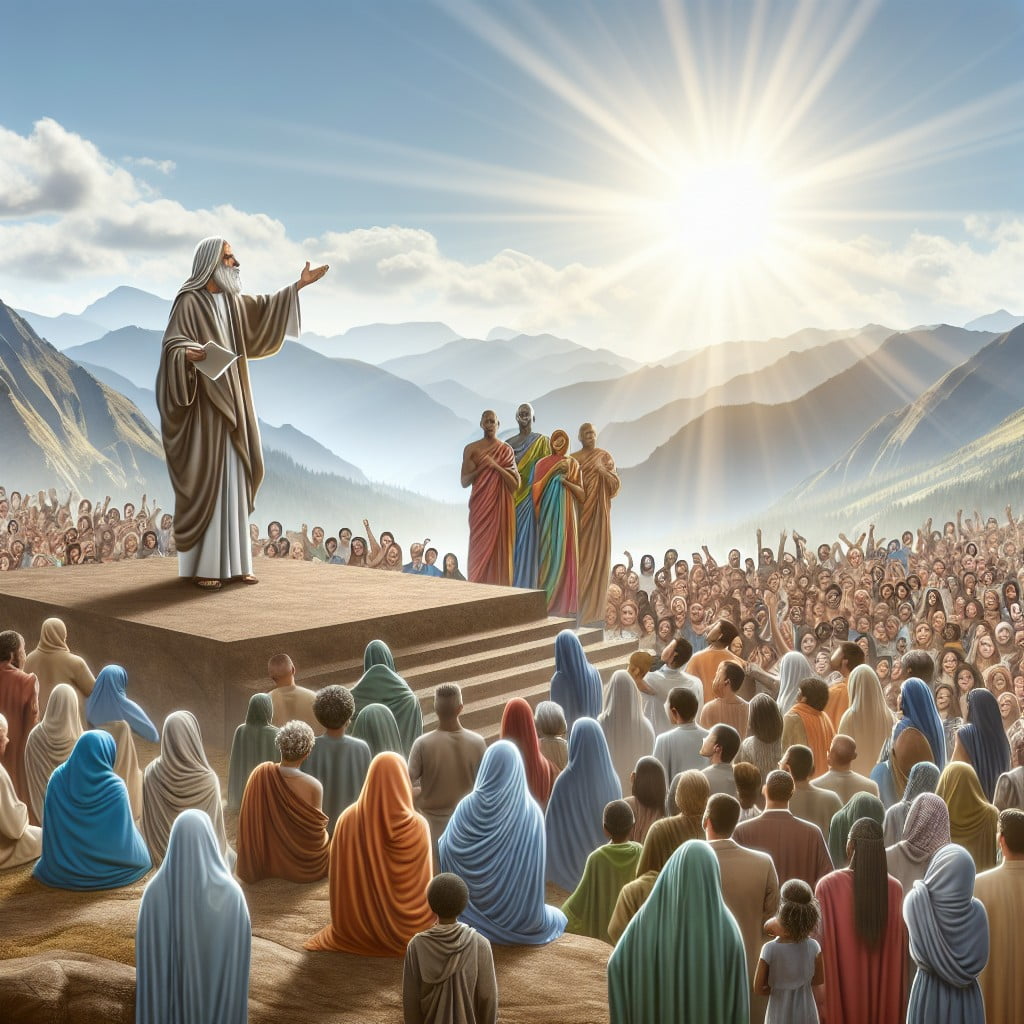Exploring Jesus on the mountain becomes intriguing because it deciphers how mindfulness and meditation can be mirrored from this spiritual perspective.
Key takeaways:
- The teachings of Jesus on the mountain include the Beatitudes, the Lord’s Prayer, ethical directives, almsgiving, prayer and fasting, treasures in heaven, and judgment and discernment.
- These teachings promote a life led by compassion, introspection, and love.
- The Sermon on the Mount emphasizes humility, mercy, inner purity, and authentic living.
- The Transfiguration reveals Jesus’ divinity and strengthens the disciples’ faith.
- The Sermon on the Mount has had a significant cultural impact in art, literature, music, ethics, and social movements.
Significance of Jesus’ Teachings On the Mountain

The teachings of Jesus on the mountain represent a cornerstone of Christian morality and spirituality, embodying profound principles that continue to resonate with followers around the world. These teachings include:
- The Beatitudes: A collection of blessings that underscore values such as humility, mercy, and peace.
- The Lord’s Prayer: This model prayer emphasizes forgiveness and the pursuit of God’s will.
- Ethical Directives: Jesus expounds on the spirit of the law, emphasizing sincerity, love, and the intention behind actions rather than mere adherence to rules.
- Almsgiving, Prayer, and Fasting: Jesus addresses these practices, advocating for genuine piety over performative religiosity.
- Treasures in Heaven: Encouraging detachment from material wealth, Jesus invites individuals to store their treasures in a spiritual sense rather than the physical.
- Judgment and Discernment: The call is to seek self-awareness and avoid hypocritical judgment of others, focusing on personal growth and understanding.
These points offer a blueprint for a life led by compassion and introspection, urging a connection with the divine and an ethic rooted in love. Their significance lies not only in religious contexts but also in their universal appeal to the pursuit of a meaningful and ethical existence.
New Testament Accounts of the Sermon On the Mount

In the Gospel of Matthew, chapters 5 through 7, we find a comprehensive account of the Sermon on the Mount, which begins with the Beatitudes, a series of blessings that invert common values, suggesting that the kingdom of heaven favors the meek and the mourning.
These opening verses set the tone for a message that emphasizes humility, mercy, and purity of heart.
The sermon continues with a call for righteousness that exceeds that of the Pharisees, challenging listeners to seek a deeper, more authentic adherence to the law.
Jesus reframes traditional understandings of the law, expanding its interpretation to include not just actions but the intentions of the heart.
Moreover, Christ introduces the Lord’s Prayer within this discourse, providing a model for prayer that underscores the importance of forgiveness and the seeking of God’s kingdom.
Emphasis on not performing religious duties for show, trusting God for provision, and not worrying about tomorrow are other key themes that highlight a life lived in faith and simplicity.
The teachings culminate with the parable of the wise and foolish builders, encapsulating the sermon’s core message: the necessity of not only hearing Jesus’s words but also acting on them, thus building a life on a solid foundation.
Theological Implications of the Teachings
The teachings of Jesus on the mountain present a radical message that underpins Christian moral perspective and vision. They urge a reorientation of values towards humility, mercy, and peace, challenging believers to strive for a higher standard of righteousness beyond mere adherence to the law. This emphasis on inner purity over ritualistic compliance is seen as a foundation for Christian spirituality.
Highlighted concepts include:
- The Beatitudes: These blessings redefine what it means to be fortunate, emphasizing spiritual prosperity over material wealth.
- Love for enemies: Jesus’ call to love one’s enemies sets a precedent for forgiveness and reconciliation, pushing the boundaries of inclusivity in community relations.
- The Lord’s Prayer: Offering a template for prayer, it points to the intimacy between the devout and the divine.
- The focus on intent: Encouraging a look at the heart’s motive rather than just actions, Jesus’ message elevates the importance of intent in ethical living.
- The metaphor of light: Reflects the role believers are to play in the world, exemplifying goodness and truth through their lives.
Understanding these elements provides a deeper appreciation of Jesus’ transformative vision for human conduct and its enduring influence on Christian thought.
The Importance of the Sermon in Christian Ethics
The Sermon on the Mount encapsulates the essence of moral guidance in Christianity, setting a high standard for believers. The Beatitudes, a cornerstone of this message, blesses those who embody spiritual virtues, promoting humility, mercy, and peace. These teachings champion a love that extends beyond friends and family, urging followers to love their enemies and pray for those who persecute them, thus fostering forgiveness and reconciliation.
Central to the sermon is the call to authentic living, highlighted in the admonition against hypocrisy. Followers are encouraged to practice righteousness not for public admiration but for the sake of genuine goodness. The emphasis on inward purity over external religious practices challenges adherents to self-reflection and integrity in their faith journey.
Additionally, the sermon sets out principles for trust and reliance on God, especially in the instruction not to worry about material needs. This aligns with the value of mindfulness, reminding believers to stay present and entrust their concerns to a higher power. By living out the precepts of the Sermon on the Mount, Christians can cultivate a life that honors both divine commands and the well-being of the communities they inhabit.
The Transfiguration of Jesus On the Mountain
In the New Testament, the Transfiguration is a pivotal event that depicts Jesus’ divine nature to a select group of his disciples. This momentous episode occurs on a high mountain, where Jesus becomes radiantly transformed:
- Peter, James, and John, key apostles of Jesus, are witnesses to this event, illustrating their special roles in his ministry.
- As Jesus shines with bright rays of light, Moses and Elijah appear beside him, symbolizing the Law and the Prophets of the Hebrew Scriptures and linking Jesus’ teachings with Jewish tradition.
- A voice from heaven, identified as God the Father, declares Jesus as His beloved Son. This divine endorsement emphasizes Jesus’ unique status and mission.
- The Transfiguration serves as a revelation to the disciples of Jesus’ glory prior to his Crucifixion and Resurrection, strengthening their faith in his ultimate victory over death.
Understanding the Transfiguration provides insight into the duality of Jesus as both fully human and fully divine, a cornerstone of Christian belief.
Identifying the Possible Locations of the Mountain
While the exact location remains uncertain, two sites are traditionally considered as the setting for the Sermon on the Mount. The Mount of Beatitudes, a small hill near Tabgha on the shore of the Sea of Galilee, is the primary location commemorated by Christians. It hosts a Roman Catholic chapel designed by the architect Antonio Barluzzi, symbolizing the event’s significance dating back to the Byzantine period.
Another possible location is the Horns of Hattin, a double hill situated west of the Sea of Galilee. This site carries historical weight for being a natural amphitheater that could accommodate large crowds, which aligns with Gospel narratives describing the multitudes who listened to Jesus.
Both locations offer serene environments that echo the peaceful essence of Jesus’ teachings, attracting pilgrims who seek spiritual reflection inspired by biblical history. Although definitive proof is absent, these traditional sites provide tangible connections for those wishing to deepen their understanding and experience of Christian scriptures.
Celebration of the Feast of the Transfiguration
The Feast of the Transfiguration is observed annually on August 6th by many Christian denominations. This day commemorates the moment when Jesus became radiant on the mountain before the eyes of Peter, James, and John, as described in the Gospels of Matthew, Mark, and Luke.
- It symbolizes the revelation of Christ’s divine glory.
- Orthodox, Catholic, Anglican, and various Protestant churches mark the occasion with special services.
- The Eastern Orthodox Church celebrates with vigils the evening before, and the Divine Liturgy on the day.
- The Western Church’s observances often include the reading of the Transfiguration account and a sermon focusing on the theological significance of the event.
- In some traditions, the blessing of fruits is a unique element of the feast, representing the firstfruits of the harvest and a metaphor for Christ’s transformation of the world.
This celebration highlights the intersection of human and divine, encouraging believers to reflect on the transformational aspect of faith and the ultimate destiny promised to humanity in Christian theology.
Cultural Impact of Jesus’ Sermon and the Transfiguration
The words spoken by Jesus on the mountain have deeply influenced Western thought and culture. For centuries, these teachings have been a cornerstone for artwork, literature, and social justice movements.
- Artwork: Renaissance paintings and modern depictions often illustrate the Sermon on the Mount, capturing the essence of Christ’s message of humility, charity, and love.
- Literature: Countless literary works reference these teachings, exploring themes like mercy, the pursuit of righteousness, and the spirit of the Beatitudes.
- Music: Various hymns and musical compositions have been inspired by the beatific vision and moral guidance offered during the sermon.
- Ethics and law: The moral precepts of the Sermon on the Mount have informed legal systems, particularly the emphasis on peace-making and fairness.
- Social movements: Leaders like Martin Luther King Jr. drew on the sermon’s principles when advocating for civil rights and nonviolent protest.
Through these facets, the cultural impact continues to encourage a society rooted in compassion and moral integrity.
Depictions of the Sermon On the Mount in Art
The Sermon on the Mount has captivated artists for centuries, serving as a profound subject for paintings, sculptures, and stained glass works. In visual art, this scene often emphasises the haloed figure of Jesus elevated on a hill, gesturing to a crowd below, symbolizing his role as teacher and leader.
Notable works include:
- 1. Cosimo Rosselli’s fresco in the Sistine Chapel, where vibrant colors and a calm landscape reflect the sermon’s peaceful teachings.
- 2. Carl Bloch’s paintings portray intimate moments during the sermon, focusing on the personal connection between Jesus and his listeners.
- 3. Stained glass windows, commonly found in churches, frequently depict this sermon to remind congregations of the Beatitudes and the principles of Christian life.
Artistic interpretations of the sermon often emphasize the contrast between the divine and human realms—the ethereal presence of Jesus against the mortal audience, underscoring the reaching of heavenly wisdom into earthly existence.
Relevance of the Sermon On the Mount in Modern Christian Practice
The Sermon on the Mount continues to serve as a cornerstone for contemporary Christian behavior, emphasizing the beatitudes—which describe the characteristics of a life in accordance with God’s kingdom—and instructing believers on how to live in harmony with each other.
Key points stress the embrace of humility, the pursuit of righteousness, and the importance of forgiveness.
Furthermore, the teachings encourage Christians to prioritize spiritual wealth over material gain and to engage in prayer with sincerity rather than for public admiration.
This passage from Matthew’s Gospel remains a reference for moral conduct and inner transformation, as followers of Jesus seek practical ways to integrate these principles into everyday life to embody the love, compassion, and justice envisioned in this formative sermon.